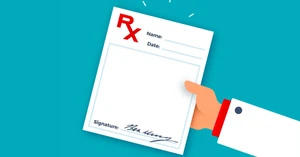What Is Prescription Assistance Tool?
Prescription assistance software is a tool used by healthcare professionals, practitioners, and physicians to electronically generate and transmit medical prescriptions to selected pharmacies. Prescription assistance tools further help doctors access the exact drug details, alternatives, and patient histories.
Prescription assistance software is critical in eliminating errors associated with illegible handwriting. Prescription assistance software is a reliable bridge between medical professionals, drug stores, and patients.
Why Use Prescription Assistance Software?
Effective management of prescriptions is crucial for maintaining optimal health, preventing medication errors, and reducing healthcare costs. PATs aid in this process by providing reminders, dosage information, and cost-saving options.
- Drug reference library: Get information regarding medical references including symptoms, diagnosis, follow-ups, and treatment.
- Increased patient convenience: These tools are convenient for the patients as prescriptions are sent directly to the pharmacies, preventing any confusion.
- Enhanced patient safety: Prescription assistance tools with their inbuilt alerting system check for drug allergies and interactions to ensure patient safety and well-being.
- No prescription errors: Prescription assistance tools enable doctors to check their patient's histories for prescribing the right treatment.
- Medication history: The history tab helps with streamlining the medical reconciliation process and ensuring patient safety.
How Does Prescription Assistance Software Work?
- e-prescribing: Doctors can write prescriptions and send them electronically to pharmacies and drugstores from the existing point of care.
- Formulary management: Prescription assistance tools offer healthcare providers, doctors, and pharmacists a secured network to prescribe the best, cost-effective, and clinically sound care plan.
- Drug reference database: Get quick access to a medicine database for checking drug-drug interactions and prescribing accordingly.
- Medication selection: Prescription assistance software provides details of alternative and generic medicines so that prescribers can select the appropriate drug accordingly.
- Prescription creation submission: Doctors can use the software to prepare prescriptions and send them from a preferred device of their choice.
- Alerts warning: Adverse interaction checks are crucial to maintaining the authenticity of treatment, and the software does it by cross-checking allergies, reactions, etc.
- Refill authorizations: The software helps pharmacists send refill requests directly to the doctors. Doctors can approve or disapprove of these as per their discretion.
- Medication history views: The software allows doctors to access the details of a patient's medical history either by importing the information from a pharmacy database or through medication claims.
Key Features of Prescription Assistance Tool
- Therapy management:: Prescription assistance tools provide physicians with a list of medicine equivalents and alternatives for preparing the best therapy plan. The plan is based on the cost-effectiveness of therapy, age limitations, disease specifications, and more.
- Tracking prescription fulfillment: Prescription assistance software platforms help doctors track the status of electronic prescriptions and view their fulfillment status.
- Adverse interaction prevention: Prescription assistance tools are integrated into EHR/EMR platforms. The integration notifies doctors of any adverse reaction that a medicine may have on the patient.
- Medication history: The software can list details of a patient's medical records easily by collecting information from a variety of sources. These sources could be electronic medical records, partners' pharmacy databases, and medication claims history.
- API integration: API integration is useful in integrating prescription assistance tools with telemedicine solutions for quick diagnosis.
- Automated medication labeling: Prescription assistance software provides online labels for medicines. The label has dosage details, expiration dates, and more for patient convenience.
- Drug interactions: Prescription assistance software offers multiple filters to let doctors check drug interactions according to individual patient parameters.
Benefits of Using PATs
- Managing complex prescriptions: The software offers medical information drawn exclusively from certified medical sources to handle even the most complex prescriptions and ensure patient safety.
- Improving patient care: With their inbuilt prescription aid APIs, these tools are helping physicians and the medical service community provide timely and accurate treatment plans to their patients.
- Virtual assistants: Virtual assistants are handy tools for healthcare professionals to access medicine details like side effects, interactions, dosage, and indications quickly.
- Auto-complete API: The API produces the therapeutic categories, active ingredients, and brand names of different drug entities in real time.
- Updated drug information: The software ensures that all information about the medicine is available from official medical sources and is compliant with existing regulations.
- Accurate prescription analysis: Get a complete overview of drug-related risks, contraindications, and possible interactions with prescription assistance software solutions.
How To Choose The Right Prescription Assistance Tool?
When choosing a Prescription Assistance Tool (PAT), it's important to consider various factors to ensure that the tool meets your specific needs. Here is a checklist to guide you through the selection process:
- Eligibility Criteria:
- Check if the PAT caters to your specific demographic (age, income level, insurance status).
- Determine if there are any disease-specific programs relevant to your needs.
- Coverage and Benefits:
- Investigate the range of medications covered.
- Look into the extent of financial assistance offered (e.g., discounts, free medications).
- Ease of Use:
- Evaluate the user interface and accessibility of the tool.
- Consider if the tool offers support via phone, email, or chat.
- Application Process:
- Assess the complexity of the application process.
- Check if the tool provides guidance or assistance in filling out applications.
- Privacy and Security:
- Ensure that the tool has robust privacy policies and data protection measures.
- Updates and Notifications:
- Find out if the tool offers regular updates on new programs or changes in existing ones.
- Check if it provides reminders for application deadlines or renewals.
- Reviews and Reputation:
- Read user reviews and testimonials.
- Research the tool’s reputation and any endorsements from healthcare providers or organizations.
- Cost:
- Consider if there are any fees associated with using the tool.
- Evaluate the cost-benefit ratio based on the potential savings on medications.
Future Trends in Prescription Assistance Tools
The landscape of prescription assistance tools (PATs) is evolving rapidly, influenced by advancements in technology, changes in healthcare policies, and the growing need for affordable medication. Emerging technologies like AI and machine learning are set to revolutionize PATs, offering even more personalized and efficient medication management. Here are some key trends that are likely to shape the future of these tools:
- Integration of Artificial Intelligence (AI) and Machine Learning (ML):
- PATs are expected to increasingly use AI and ML to personalize recommendations based on a user's health profile, medication history, and financial situation.
- AI could also be used to predict changes in medication prices and suggest the best time to purchase.
- Enhanced Mobile Accessibility:
- With the growing reliance on smartphones, PATs will likely become more mobile-friendly, offering user-friendly apps that provide seamless access to assistance programs.
- Features like barcode scanning for price comparisons and reminders for medication refills or program renewals could become standard.
- Greater Data Integration:
- Integration with electronic health records (EHRs) and pharmacy systems will enable more accurate and efficient service.
- This could facilitate automatic alerts about eligibility for assistance programs based on prescription and health data.
- Blockchain for Improved Security and Transparency:
- Blockchain technology may be used to enhance the security and privacy of patient data in PATs.
- It could also bring transparency to drug pricing and the funding sources of assistance programs.
- Telehealth Integration:
- As telehealth services expand, PATs might integrate with these platforms to offer real-time prescription assistance during virtual doctor visits.
- This could streamline the process of finding financial assistance for prescriptions immediately after they are prescribed.
- Expansion of Services:
- PATs might begin offering more comprehensive services, including assistance with medical devices, diagnostic tests, and other healthcare services beyond just medications.
- They could also provide educational content and tools for managing various health conditions.
- Policy and Advocacy:
- Some PATs may evolve to play a more active role in healthcare advocacy, working to influence policies that make medications more affordable and accessible.
- Partnerships and Collaborations:
- Collaborations between PATs, pharmaceutical companies, healthcare providers, and insurance companies are expected to increase, aiming to create more holistic and patient-centered assistance programs.
- User Experience and Personalization:
- Enhancing the user experience through personalized interfaces, easy navigation, and responsive design will be a focus to increase engagement and effectiveness.
- Global Expansion and Localization:
- As the need for prescription assistance is global, PATs might expand their services to more countries, adapting to local healthcare systems, languages, and regulations.



















